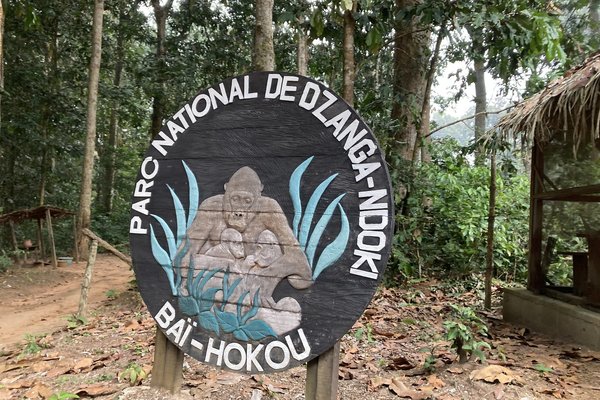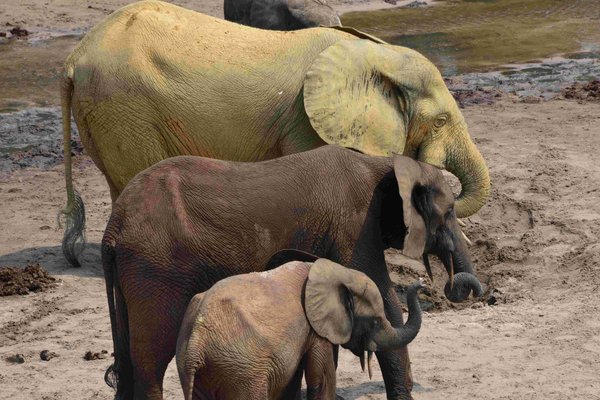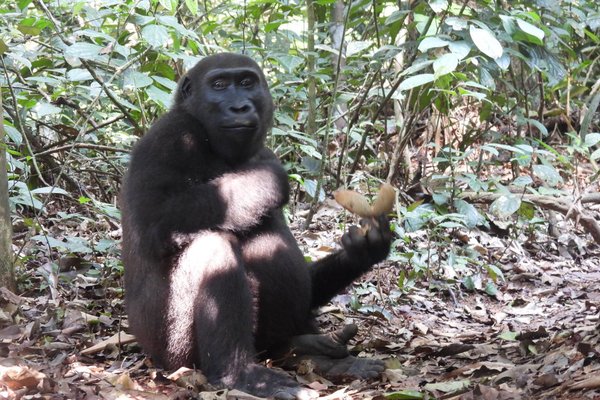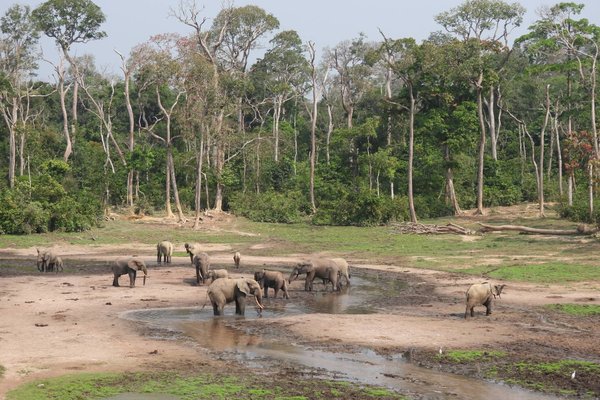Cameroon, Central African Republic, Congo (Republic)
Sangha Trinational
Sangha Trinational is a large and intact natural landscape, mainly consisting of humid forests plus wetlands and natural clearings.
These three contiguous national parks are centered along the Sangha River, a tributary to the Congo River. They harbour tree and mammal species that are much threatened elsewhere due to exploitation and poaching. Large mammals such as Forest Elephants, Gorillas, Chimpanzees, Sitatunga and Bongo are still present in healthy numbers.
Community Perspective: Els visited Dzanga-Ndoki National Park in the Central African Republic, as did Randi, arriving from Congo by the Sangha River. The other two parks, Lobéké National Park in Cameroon and Nouabalé-Ndoki National Park in Congo, have stayed unreviewed so far.
Site Info
Official Information
- Full Name
- Sangha Trinational (ID: 1380)
- Countries
- Cameroon Central African Republic Congo (Republic)
- Status
-
Inscribed 2012
Site history
History of Sangha Trinational
- 2012: Inscribed
- Inscribed
- 2011: Referred
- 2011: Advisory Body overruled
- IUCN had advised Deferral
- Type
- Natural
- Criteria
- ix
- x
Links
- UNESCO
- whc.unesco.org
- Official
-
- fondationtns.org — The Sangha Tri-National Trust Fund
- Related
-
- cokesmithphototravel.com — Expedition to Dzangha-Ndoki National Park (2012)
- myafricansojourn.blogspot.nl — A visit to Lobéké National Park (2014)
All Links
UNESCO.org
- whc.unesco.org — whc.unesco.org/
Official Website
- fondationtns.org — The Sangha Tri-National Trust Fund
Related Resources
- cokesmithphototravel.com — Expedition to Dzangha-Ndoki National Park (2012)
- myafricansojourn.blogspot.nl — A visit to Lobéké National Park (2014)
News Article
- May 17, 2024 instagram.com — Dzanga Sangha loses its silverback Makumba
- Oct. 6, 2021 news.mongabay.com — Cameroon plans a new road in Lobéké National Park
- May 10, 2013 wildlifenews.co.uk — Elephant death toll at Dzanga Bai starts to come in
- May 9, 2013 iol.co.za — Elephants butchered in Dzanga-Sangha
Community Information
- Community Category
- Natural landscape: Forest
Travel Information
Transboundary sites
Red Zone Travel Advisory
One thousand visitors or fewer
Recent Connections
-
Red Zone Travel Advisory
C.A.R. fully off-limits, Cameroon part … -
Over 100 mammal species
"Dzanga-Sangha National Park in the Cen… -
Plant WHS not in a CPD
"The property represents a wide spectru…
Connections of Sangha Trinational
- Geography
-
-
Congo River Basin
Situated in the north-western Congo Basin
-
- Trivia
-
-
Cryptozoology
Mokole-Mbembe
-
- Ecology
-
-
Swamps and Marshes
"a great diversity of wetland types, including swamp forests" (OUV) -
Chimpanzee habitat
"Two hominoids, the Western Lowland Gorilla (Critically Endangered) and the Chimpanzee (Endangered), have important populations in and around the nominated property. Both are believed to reach among their highest population densities anywhere." (AB ev) -
Elephants
Forest elephants -
Over 100 mammal species
"Dzanga-Sangha National Park in the Central African Republic alone is home to at least 105 mammal species." (WWF)See wwf.panda.org
-
Rainforests
-
Crocodiles
Nile crocodiles -
Endemic Bird Species
Sangha Forest Robin -
Gorilla habitat
Western Lowland Gorilla; has habituated groups in C.A.R. and Congo components -
Salt Flats
Dzanga Bai is a sandy salt lick that measures 250 m (820 ft) by 500 m (wiki) -
Strepsirrhini
southern needle-clawed bushbaby, Gabon bushbaby, dwarf bushbaby, potto, golden angwantibo -
Pangolin
home to giant, white-bellied and black-bellied species of pangolins -
High-Biodiversity Wilderness Area
Congo Basin -
Critically endangered fauna species
Western Lowland Gorilla, African Forest Elephant
-
- Damaged
-
-
Poaching
Excessive commercial poaching for bush meat and/or trophies may well constitute the single most important threat to TNS. Poaching for ivory remains a strong concern despite successful anti-poaching efforts, including across international boundaries.See whc.unesco.org
-
- World Heritage Process
-
-
First inscriptions
Congo (2012) -
Slow Starters
1987-2012 : 25 years (Rep. Congo) -
Transboundary sites
3 countries (Cameroon, Centr. Afr. Republic, Congo (Republic))
-
- Human Activity
-
-
Traditional Hunting
Baka indigenous people have the right to extract natural resources within Lobéké NP (IUCN Outlook 2020) -
Indigenous groups expelled
Baka . “This pattern is similar in CAR and Congo and, in all three countries, large areas customarily used by Pygmy communities have been included in national parks, where all access is prohibited.” (WHS-IPR)
-
- WHS on Other Lists
-
-
Ramsar Wetlands
Fleuve Sangha situé en République Centrafricaine - Partie camerounaise du fleuve Sangha - Sangha-Nouabalé-Ndoki -
Plant WHS not in a CPD
"The property represents a wide spectrum of the species-rich humid tropical forests in Central Africa’s Congo Basin, and provides protection for a range of endangered species. The flora is enriched by species occurring exclusively in the many types of forest clearings."
-
- Visiting conditions
-
-
Red Zone Travel Advisory
C.A.R. fully off-limits, Cameroon part as well due to proximity to C.A.R., only Congo part is not advised against -
One thousand visitors or fewer
DD: “The development of touristic infrastructure is adequate for such a remote area and seems appropriate to deal with the currently very low numbers of visitors” (AB ev)
-
- WHS Names
-
-
Named after a River
Sangha
-
News
- instagram.com 05/17/2024
- Dzanga Sangha loses its silverback…
- news.mongabay.com 10/06/2021
- Cameroon plans a new road in Lobék…
- wildlifenews.co.uk 05/10/2013
- Elephant death toll at Dzanga Bai …
Community Reviews
Show full reviews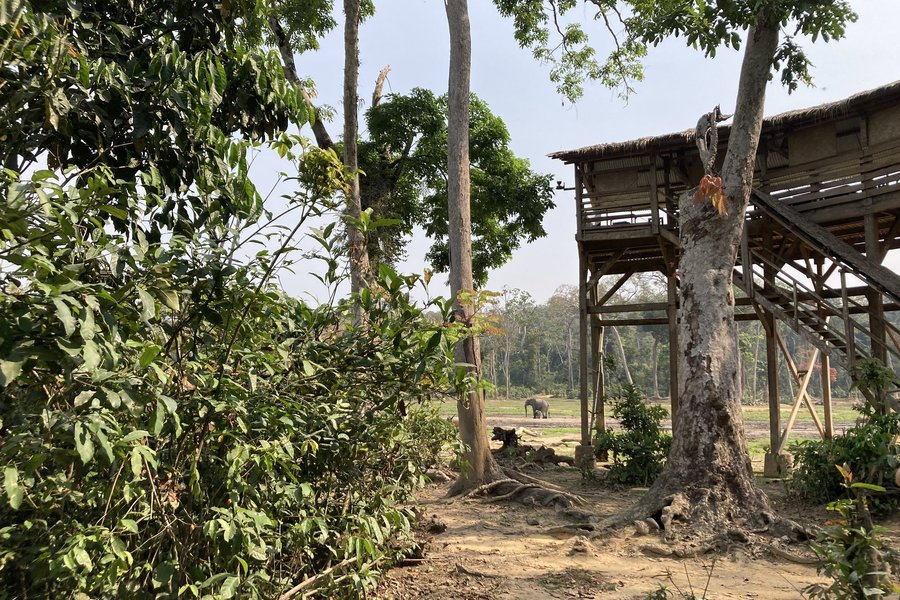
These natural clearings filled with wildlife from the Congo Basin are the holy grail among mammal watchers. For me, Dzanga Ndoki (the Central African Republic part of this transnational site) was to be a splurge visit in March 2020 – but it became my Covid travel disaster. After the park reopened, I still wanted to go but the prices rose beyond belief. Fortunately, I found a group tour operator wanting to do it for much less by entering overland from Cameroon.
This site also had been unreviewed so far on this website. Sangha Trinational WHS consists of 3 parks, of which the one in the Central African Republic (C.A.R.) surprisingly is the best equipped to receive visitors. Lobéké in Cameroon is rundown, while Nouabalé-Ndoki in Congo is temporarily closed and rumours have it that they want to turn it into a luxury destination. I wrote a Getting There topic on the Forum to elaborate on the practicalities of visiting the park in the C.A.R. This review further deals with what you can expect there.
Our first day was spent at Dzanga Bai, the most famous forest clearing, known as ‘the Serengeti of the Forest’. It’s already a fine place to get to, starting with a drive through the forest of about 45 minutes and then an easy hike of the same duration. The latter includes a foot crossing of some flooded areas, where the water reaches just below the knee. Especially on the way back the cool water provided a …
Keep reading 2 comments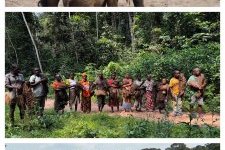
After a long day on the Sangha River from Oesso, we arrived at Dzanga-Sangha National Park we arrived at eight o’clock, the last leg in darkness. The speedboat journey through untouched nature, passing isolated villages and local fishermen, was serene and surreal - we encountered only one motorized boat the entire day.
Our stay was at Doli Lodge, managed by WWF and beautifully situated on the Sangha River. The lodge exceeded expectations and offered more comfort than its counterpart in Odzala-Congo. Though the original plan was for four nights, it was shortened to three due to the temporary suspension of gorilla trekking. The unfortunate loss of the last silverback means the groups need time to stabilize. However, the park has much more to offer.
Day 1:The day began with a visit to Dzanga Bai, the most famous mineral-rich clearing in the area. A 45 minutes drive, then a 40-minute easy walk, including a river crossing, brought us to this magical spot. As we arrived, around 120 forest elephants of different sizes and colors were gathered on the plain. What a sight!. It was mesmerizing to sit in the observation tower and watch their coming and going. They even have their own spa treatment covering themselves in golden mud. Researchers counted up to 144 elephants at its peak, an unparalleled wildlife experience. Late in the afternoon, a family of forest hogs made an appearance. At four o’clock, we returned to the lodge for a cold beer and a …
Keep reading 0 comments
